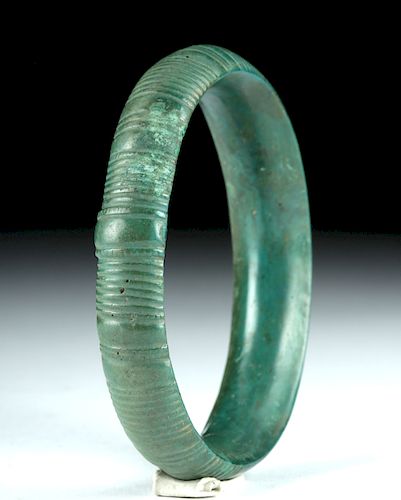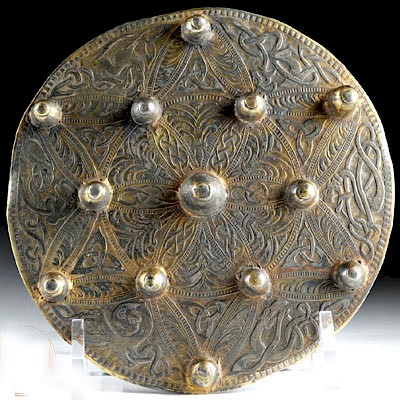Hallstatt Bronze Bracelet / Armband - Stunning Patina
Lot 51b
About Seller
Artemis Gallery
686 S Taylor Ave, Ste 106
Louisville, CO 80027
United States
Selling antiquities, ancient and ethnographic art online since 1993, Artemis Gallery specializes in Classical Antiquities (Egyptian, Greek, Roman, Near Eastern), Asian, Pre-Columbian, African / Tribal / Oceanographic art. Our extensive inventory includes pottery, stone, metal, wood, glass and textil...Read more
Estimate:
$1,200 - $1,800
Absentee vs Live bid
Two ways to bid:
- Leave a max absentee bid and the platform will bid on your behalf up to your maximum bid during the live auction.
- Bid live during the auction and your bids will be submitted real-time to the auctioneer.
Bid Increments
| Price | Bid Increment |
|---|---|
| $0 | $25 |
| $300 | $50 |
| $1,000 | $100 |
| $2,000 | $250 |
| $5,000 | $500 |
| $10,000 | $1,000 |
| $20,000 | $2,500 |
| $50,000 | $5,000 |
| $100,000 | $10,000 |
| $200,000 | $20,000 |
About Auction
By Artemis Gallery
Jul 19, 2018
Set Reminder
2018-07-19 10:00:00
2018-07-19 10:00:00
America/New_York
Bidsquare
Bidsquare : Fine Antiquities/Ethnographic Art
https://www.bidsquare.com/auctions/artemis-gallery/fine-antiquities-ethnographic-art-3329
Featuring classical antiquities, ancient and ethnographic art from cultures encompassing the globe, plus fine art. Artemis Gallery info@artemisgallery.com
Featuring classical antiquities, ancient and ethnographic art from cultures encompassing the globe, plus fine art. Artemis Gallery info@artemisgallery.com
- Lot Description
Central Europe, early Hallstatt culture, ca. 800 BCE. A superb bronze bracelet or armband of a thick composition cast using the lost wax (cire perdue) technique. The heavy accessory has a rounded interior surface with linear and stippled pattern-molded motifs along the exterior. Adding to the elegant appearance are layers of stunning emerald-green patina that have a silky-smooth texture. An amazing example of high-quality bronze-smithing from ancient Europe! Size: 3.25" Diameter (8.3 cm); 2.5" W on the interior (6.4 cm).
Hallstatt culture developed from the earlier Urnfield culture, and would progress into the later La Tene culture, which is often called Celtic. However, these names and classifications have been imposed upon ancient peoples by archaeologists and historians (Hallstatt, for example, takes its name from the type site, which is located in Austria southeast of Salzburg). Roughly 2700 years ago, these people lived in small groups, probably loosely confederated for trading purposes but engaging in frequent warfare. Elites controlled powerful hillforts and revered the horse, traveling by and perhaps warring with chariots. They were buried with beautiful bronze jewelry like this.
Provenance: private New York, USA collection; ex-private collection, alpine region, acquired 1990s
All items legal to buy/sell under U.S. Statute covering cultural patrimony Code 2600, CHAPTER 14, and are guaranteed to be as described or your money back.
A Certificate of Authenticity will accompany all winning bids.
We ship worldwide and handle all shipping in-house for your convenience.
#136880Surface wear and minor abrasions commensurate with age, small nicks to exterior surfaces, and light fading to finer details, otherwise intact and excellent. Light earthen deposits within recessed areas, and stunning green patina throughout.Condition
- Shipping Info
-
All shipping is handled in-house for your convenience. Your invoice from Artemis Gallery will include shipping calculation instructions. If in doubt, please inquire BEFORE bidding for estimated shipping costs for individual items.
-
- Buyer's Premium



 EUR
EUR CAD
CAD AUD
AUD GBP
GBP MXN
MXN HKD
HKD CNY
CNY MYR
MYR SEK
SEK SGD
SGD CHF
CHF THB
THB













